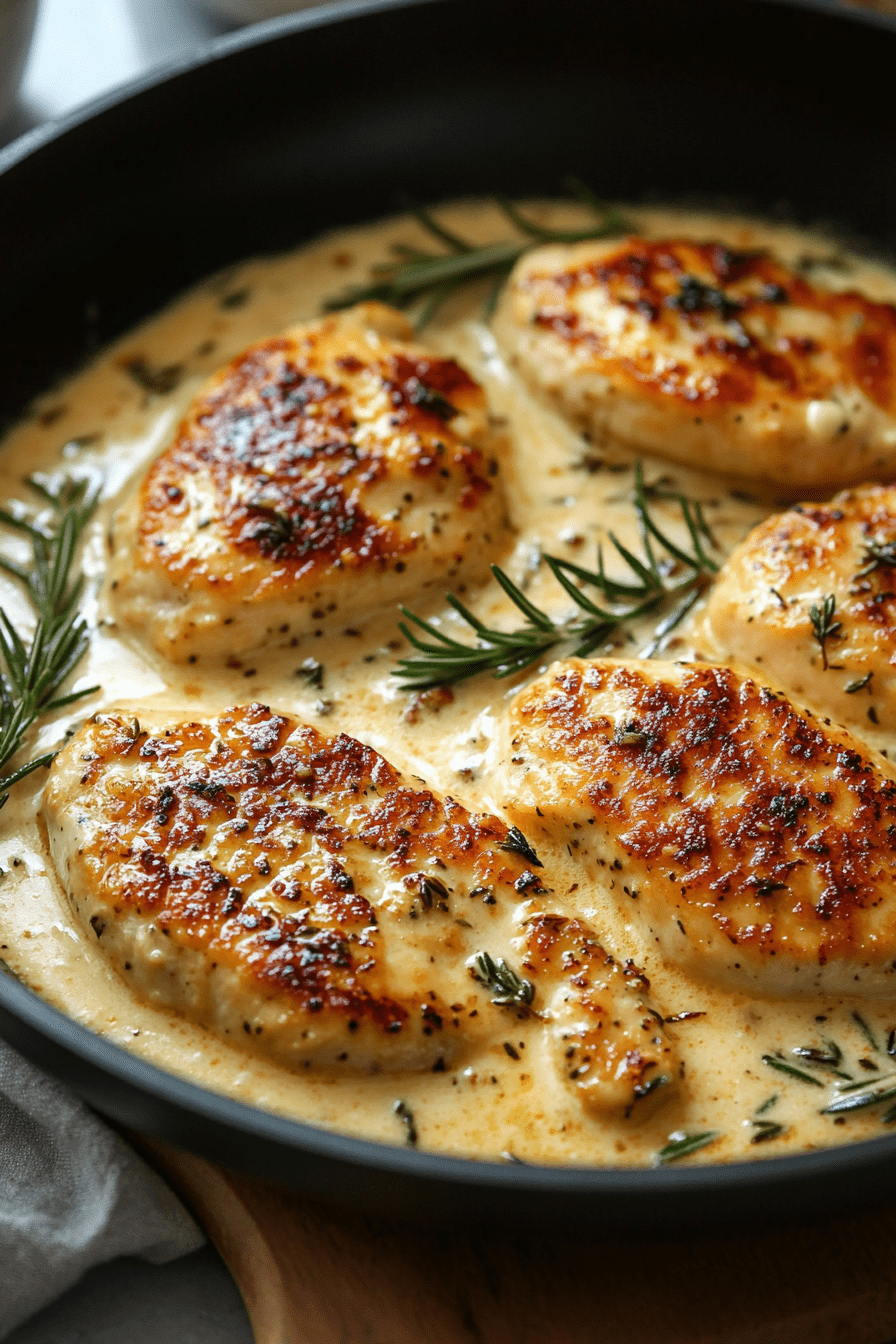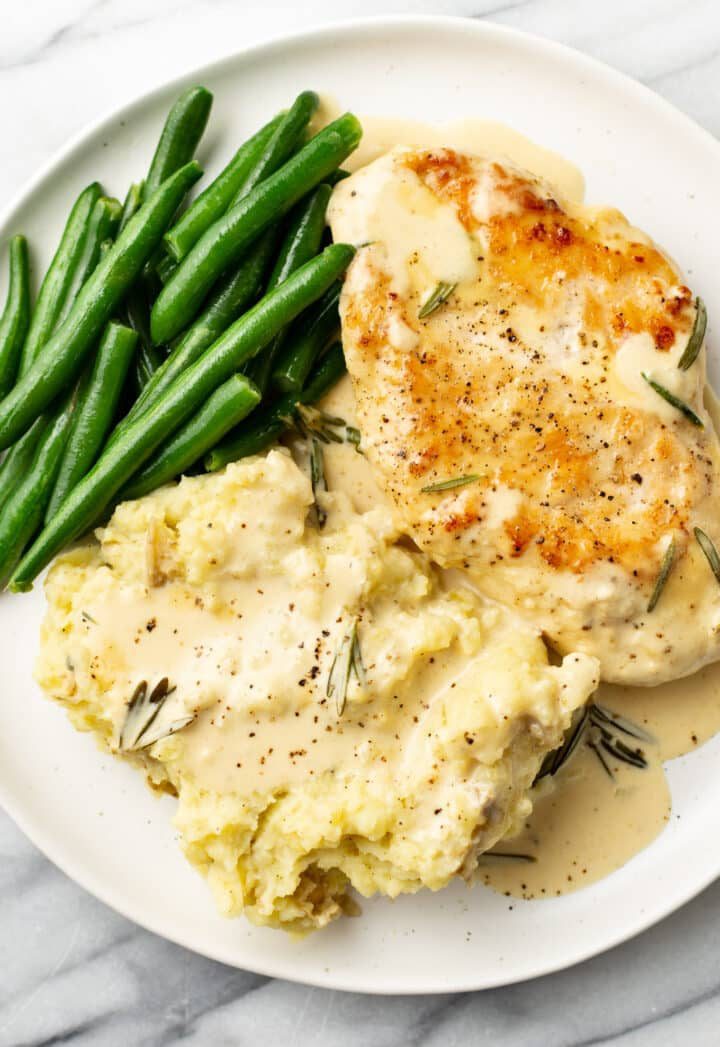Creamy Dijon Rosemary Chicken is a delicious recipe that combines amazing flavors and textures.
Creamy Dijon Rosemary Chicken is the epitome of elegant comfort food, combining tender chicken with a luxurious sauce that balances tangy, herbal, and creamy flavors in perfect harmony. This dish features chicken breasts marinated in Dijon mustard and rosemary, pan-seared to golden perfection, and finished in a velvety sauce that amplifies the marinade flavors while adding richness and depth. The result is a restaurant-quality meal that feels special enough for company yet simple enough for weeknight dinners.
What makes this dish exceptional is its sophisticated flavor profile achieved with relatively simple techniques. The Dijon mustard provides tanginess and slight heat that cuts through the richness of the cream sauce. The rosemary adds earthy, pine-like notes that complement both the chicken and the sauce. The Parmesan cheese contributes umami depth and helps thicken the sauce naturally. The pan-searing process creates fond (browned bits) that become the flavor foundation for the sauce, ensuring no deliciousness is wasted. This dish demonstrates how a few quality ingredients, when treated properly, can create something greater than the sum of its parts.
The History of Mustard in French Cuisine
Dijon mustard originated in the Burgundy region of France in the 19th century, when Jean Naigeon substituted verjuice (the acidic juice of unripe grapes) for vinegar in the traditional mustard recipe. This created a smoother, less acidic mustard that became famous worldwide. The combination of mustard with cream and herbs is classic to French cuisine, particularly in dishes like poulet à la moutarde that highlight how mustard can both tenderize meat and create complex sauces.

This particular version with rosemary represents a modern interpretation that incorporates Mediterranean influences. Rosemary has been used in cooking since ancient times, particularly in Italian and French cuisines where it grows abundantly. The combination of French technique with Mediterranean flavors reflects the globalization of culinary traditions and the modern preference for dishes that cross cultural boundaries while maintaining coherence and balance.
Ingredient Selection Guide
Mustard Quality: Use authentic Dijon mustard for the best flavor. It should have a smooth texture and balanced tanginess. Whole grain Dijon can be used for textural interest. Avoid yellow mustard which has different flavor profile.
Chicken Preparation: Boneless, skinless chicken breasts work best for even cooking. Pound to uniform thickness to prevent uneven cooking. Chicken thighs can be used for more flavor but will require longer cooking time.

Herb Freshness: Fresh rosemary is essential for the best flavor. Dried rosemary can be used but use half the amount as it’s more concentrated. Other herbs like thyme or tarragon work well as substitutes or additions.
Dairy Products: Use heavy cream for the richest sauce. Half-and-half can be used but may result in thinner sauce. Freshly grated Parmesan melts better than pre-shredded. European-style butter with higher fat content provides better flavor.
The Science of Pan Sauces
Pan sauces leverage the Maillard reaction—the chemical reaction between amino acids and reducing sugars that creates complex flavor compounds when browning occurs. The fond (browned bits) left in the pan after searing the chicken contains these flavor compounds dissolved in fat. Deglazing with liquid (chicken broth) dissolves the water-soluble compounds, while the fat-soluble compounds emulsify with the cream and butter to create a stable sauce.

The mustard acts as both flavoring and emulsifier, helping to create a smooth, stable sauce. The Parmesan cheese contributes casein proteins that further stabilize the emulsion while adding umami flavor. The gentle simmering allows the sauce to thicken through reduction without breaking the emulsion.
Step-by-Step Technique Mastery
Chicken Preparation: Pounding the chicken to even thickness is crucial for even cooking. Place between plastic wrap and use a rolling pin or meat mallet. Season generously as some seasoning will be lost during cooking.
Searing Technique: Pat chicken dry before adding to the hot pan to ensure proper browning. Do not move the chicken for the first few minutes to allow a crust to form. The chicken should release easily when properly seared.

Sauce Development: Do not rush the sauce-making process. Cook the shallots until softened but not browned. Deglaze thoroughly to incorporate all the fond. Add cream off the heat initially to prevent curdling.
Finishing: Return the chicken to the sauce just to heat through, not to continue cooking. Adjust seasoning at the end as reducing concentrates flavors. Add fresh herbs at the end to preserve their flavor.
Flavor Development Secrets
Enhance the marinade by adding a teaspoon of honey or maple syrup for subtle sweetness that balances the mustard’s tang. A splash of white wine in the marinade adds complexity.
For extra depth, add a teaspoon of tomato paste when cooking the shallots and cook until it darkens slightly. A pinch of red pepper flakes adds subtle heat that complements the mustard.
Infuse the cream by warming it with rosemary sprigs before adding to the sauce. Strain before using. For luxury, finish the sauce with a tablespoon of cold butter off the heat for extra shine and richness.
Professional Presentation Techniques
Slice the chicken on the bias before serving for elegant presentation. Fan out slices on the plate for visual appeal. Spoon sauce over and around, not completely covering the chicken.
Garnish with fresh rosemary sprigs and lemon twists for color contrast. A sprinkle of smoked paprika or microgreens adds visual interest. Serve on warm plates to maintain temperature.
Create height by serving with mashed potatoes or polenta as a base. Arrange vegetables neatly around the plate. Drizzle plates with reduced balsamic or herb oil for restaurant-style presentation.
Nutritional Considerations
This dish provides high-quality protein from chicken, calcium from dairy, and various nutrients from the herbs and aromatics. However, it also contains significant saturated fat from the cream and butter.
For a lighter version, use Greek yogurt instead of cream, though the sauce will be tangier. Reduce the amount of butter or use olive oil. Increase vegetable portions to balance the meal.
For dairy-free, use coconut cream and nutritional yeast instead of Parmesan. For gluten-free, ensure the Dijon mustard is gluten-free (some brands contain wheat flour).
Storage and Freshness Preservation
The completed dish is best served immediately, but components can be prepared ahead. The chicken can be marinated for up to 24 hours refrigerated. The sauce can be made ahead and reheated gently.
Leftovers can be refrigerated for 3-4 days. Reheat gently to prevent the sauce from separating. The sauce may thicken when chilled—thin with a little broth or cream when reheating.
Freeze without the cream sauce for best results. The chicken can be frozen after cooking for up to 3 months. Thaw in refrigerator before reheating and making fresh sauce.
Cultural Significance and Modern Adaptations
Creamy Dijon Rosemary Chicken represents the evolution of classic French technique in modern home cooking. It reflects the contemporary preference for dishes that feel restaurant-quality but are achievable for home cooks. The combination of familiar flavors in an elegant preparation makes it perfect for both family dinners and entertaining.
Contemporary variations include different mustards (whole grain, honey Dijon), additional ingredients (mushrooms, sun-dried tomatoes, capers), or alternative proteins (pork, fish, tofu). These adaptations demonstrate the versatility of the basic formula while maintaining the essential balance of flavors.
Final Thoughts
Creamy Dijon Rosemary Chicken offers the perfect combination of elegance and comfort, sophistication and simplicity. Its restaurant-quality appearance belies its straightforward preparation, making it perfect for both special occasions and everyday meals. As you experience the harmony of tangy mustard, aromatic rosemary, and rich cream sauce, appreciate how this dish transforms simple ingredients into something extraordinary. May this recipe become a cherished part of your culinary repertoire, bringing joy and satisfaction to your table.

Creamy Dijon Rosemary Chicken
Ingredients
Method
- Pound chicken breasts to even thickness (about ½ inch)
- Combine Dijon mustard, olive oil, garlic, rosemary, salt, and pepper
- Coat chicken evenly with marinade
- Let sit for 15-30 minutes at room temperature
- Heat a large skillet over medium-high heat
- Add chicken and cook for 5-6 minutes per side until golden
- Remove chicken from skillet and set aside
- Cover to keep warm
- Reduce heat to medium, add butter to skillet
- Sauté shallot until softened, about 2 minutes
- Add chicken broth, scraping up browned bits from pan
- Stir in cream, Dijon mustard, and rosemary
- Simmer until slightly thickened, about 3 minutes
- Stir in Parmesan cheese until melted and smooth
- Return chicken to skillet, spoon sauce over top
- Simmer for 2-3 minutes until chicken is heated through
- Adjust seasoning with salt and pepper if needed
- Garnish with fresh parsley and serve with lemon wedges
- Serve over mashed potatoes or pasta with vegetables



